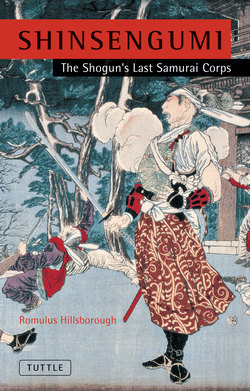Читать книгу Shinsengumi - Romulus Hillsborough - Страница 14
На сайте Литреса книга снята с продажи.
ОглавлениеPreface
This book is about bloodshed and death and atrocity. It is also about courage and honor and fidelity. It explores some of the darkest regions of the human soul, and some of its most noble parts. The underlying themes in this historical narrative of the Shinsengumi are the extraordinary will to power and sense of self-importance of the leaders of that most lethal samurai corps, and the unsurpassed propensity to kill instilled by them into the rank and file.
The leaders of the Shinsengumi—Kondō Isami and Hijikata Toshizō—are among the most celebrated men in Japanese history. Much has been written about the Shinsengumi, by acclaimed writers of Japanese history and by former Shinsengumi corpsmen. They have also been widely depicted—and romanticized—in numerous novels, period films, and, more recently, comic books and animation. In writing this first English-language narrative of the Shinsengumi, I have given precedence to capturing their essence and the main events of their history, rather than merely rewriting the tedious facts of their history. I have concentrated on the spirit of the Shinsengumi and their place in history, rather than on trivial details, particularly for situations in which my numerous sources contradict one another—with disconcerting frequency.
The causes for such contradictions are inevitable. Much of the information available about the Shinsengumi is fragmentary. Many of the facts regarding the corps have been lost to history. For example, depending on the source, it might or might not have been raining on the night that Serizawa Kamo was assassinated. While the sound of pouring rain adds a certain melodramatic element to the scene, exceedingly more important than the weather are the reasons that Serizawa was assassinated, the circumstances of the bloody incident, and its historical consequences. As another example, the cause of Okita Sōji’s collapse during the furious and bloody battle at the Ikéda’ya inn is uncertain. Whether the cause was a sudden attack of tuberculosis or the intense heat inside the house on that hot summer night in 1864 is of far less importance than the fact that the genius swordsman killed numerous men with his sword before collapsing, and the far-reaching effect of his sword on Japanese history.
In this regard I must mention that this narrative is based entirely on historical documents and records, historical narrative and biographies (including definitive histories of the Shinsengumi and biographies of their men and other contemporaries), letters, diaries, memoirs and recollections (including firsthand and secondhand oral accounts and interviews), and other widely accepted sources. However, to the question of whether this narrative is entirely nonfiction, my answer must be a carefully considered yet resounding no. No, because I do not believe that any of my source materials are entirely foolproof—although to the best of my knowledge they are the truest and best available sources on this history. All historical documents and written histories, in that they are recorded after the fact and are not simultaneous depictions of men and events, must be, to a certain extent, flawed. Even eyewitness accounts of events are naturally flawed by biases, preconceptions, and myriad viewpoints, accented by the countless, or perhaps uncountable, perceptions inherent in the individual human mind. Thomas Carlyle, the master historical essayist, summed up this inevitable condition simply but truly: “The old story of Sir Walter Raleigh’s looking from his prison window, on some street tumult, which afterwards three witnesses reported in three different ways, himself differing from them all, is still a true lesson for us.”*
In this light, I pose a question: Even in this day and age of advanced technology, is there a newspaper account of current events absolutely and undoubtedly free of misinterpretation of human intention or just plain factual error? How could the answer be but no at the beginning of the twenty-first century, when deception and lies are rampant at the highest levels of government, as they were in Japan during the 1860s and have been among organizations composed of human beings since the beginning of recorded history? Let it suffice to say, then, that this historical narrative is nonfiction in that my intent throughout has been, to the best of my ability, to present a coherent and accurate picture of the men and events of the Shinsengumi.
“Stern Accuracy in inquiring, bold Imagination in expounding ... are the two pinions on which History soars,” Carlyle wrote.† The gist of this message by the visionary historian is that while we cannot know the certain truth of human events and actions which we ourselves have not witnessed, we can, by force of careful scrutiny, depict a clearer template from an otherwise muddled parade of uncorrelated facts of history and embellish this clarified image with fleeting and boundless leaps of “bold Imagination,” to paint a picture that reflects the soul and essence of great human events and actions. This is what I have attempted in these pages. Whether I have succeeded, I leave to the reader to judge.
— Romulus Hillsborough
January 2005
___________________
* Thomas Carlyle, “On History,” Thomas Carlyle: Historical Essays (University of California Press, 2002), p. 6
† Thomas Carlyle, “Count Cagliostro,” Thomas Carlyle: Historical Essays (University of California Press, 2002), p. 32.
